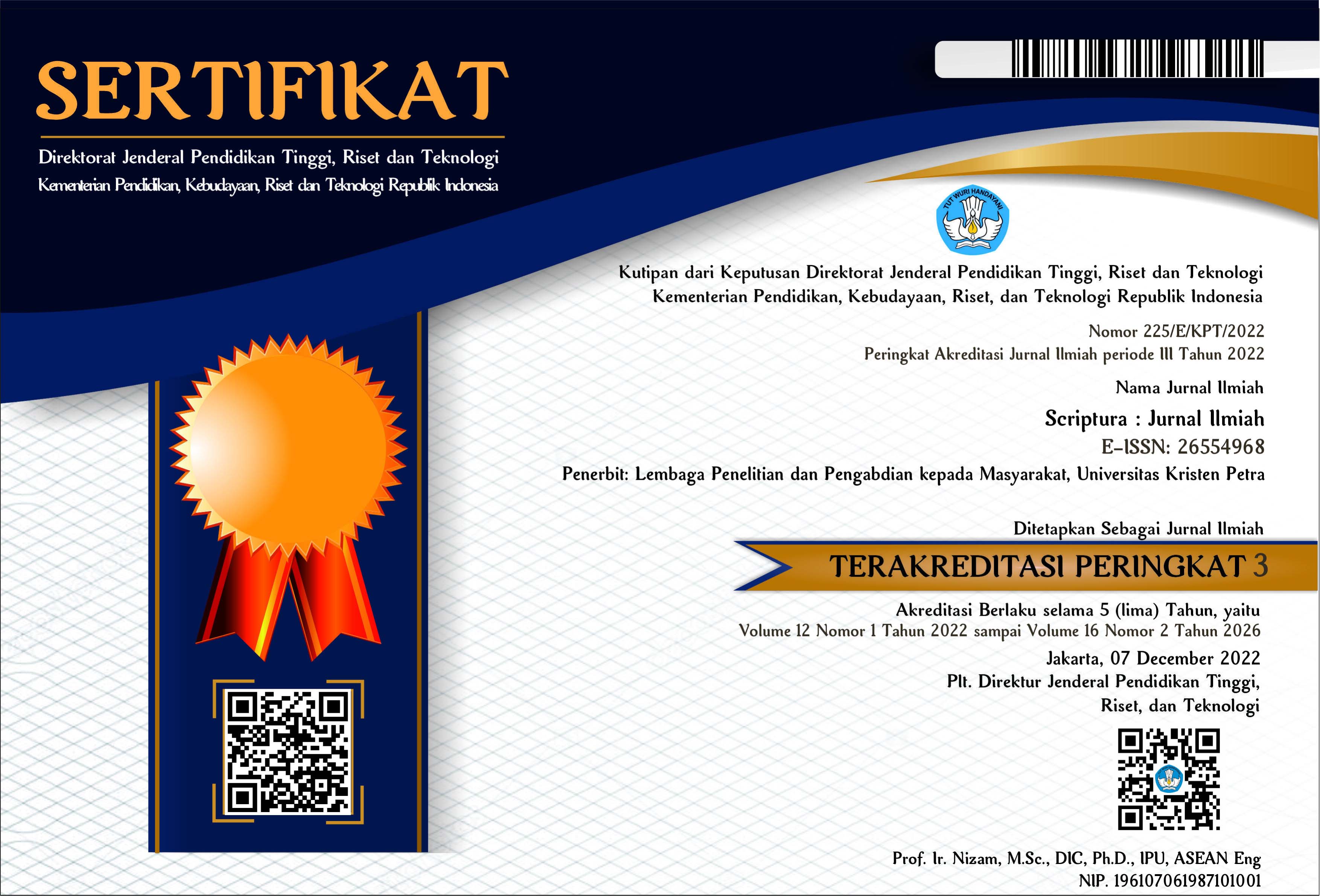EMPATI DAN HOMOFILI DALAM KOMUNIKASI POLITIK PEMENANGAN PEMILIHAN LEGISLATIF
 :
:
https://doi.org/10.9744/scriptura.9.2.82-90
Keywords:
political communication, empathy, homophily, thoriqoh congregationAbstract
Empathy and homophily communication in campaigns is important to garner public support in the era of democracy. Loyal community support can be achieved if political actors make empathy and homophile communication appropriately. This study aims to find out how empathy and homophile communication carried out by Gus, a legislative candidate, is able to win votes from a community that is basically apathetic to politics, namely the thoriqoh congregation. The research method used is a qualitative approach, with in-depth interview and observation data collection techniques. The results showed that the communication of empathy and homophilia carried out by Gus, made it seen as part of the Thoriqoh congregation itself thus increasing its credibility. The homophile aspect fulfilled by Gus so that he gets full loyal support from the Thoriqoh congregation is in terms of equality in dressing, religion, speaking, behaving, and in carrying out rituals.
References
Agnew, J., & Shin, M. (2016). Electoral Dramaturgy: Insights from Italian Politics about Donald Trump’s 2015-2016 Campaign Strategy and Beyond. Southeastern Geographer, 56(3), 265-272.
Arifin, Anwar. (2011). Komunikasi Politik: Filsafat, Paradigma, Teori, Tujuan, Strategi dan Komunikasi Poliitik Indonesia. Yogyakarta: Graha Ilmu.
Ariton-Gelan, C. (2015). Ethical Perspectives in the Analysis of Persuasion. Mircea cel Batran Naval Academy Scientific Bulletin, 28(1), 276-279.
Basov, N. (2019). The Ambivalence of Cultural Homophily: Field Positions, Semantic Similarities, and Social Network Ties in Creative Collectives. Poetics, (October 2018), 101353. https://doi. org/10.1016/j.poetic.2019.02.004
Bratu, S. (2013). Deconstructing Political Advertising: The Cognitive Processes Underlying Voting Behavior. Journal Geopolitics, History, and International Relations, 5(1).
Carcasson, M., Black, L. W., & Sink, E. S. (2010). Communication Studies and Deliberative Democracy: Current Contributions and Future Possibilities. Journal of Public Deliberation, 6.
Claassen, R. L. (2011). Political Awareness and Electoral Campaigns: Maximum Effects for Minimum Citizens? Political Behaviour, 33(2), 203-223.
Colleoni, E., Rozza, A., & Arvidsson, A. (2014). Echo Chamber or Public Sphere? Predicting Political Orientation and Measuring Political Homophily in Twitter Using Big Data. Journal of Communication, 64(2), 317–332. https://doi. org/10.1111/jcom.12084
Egidi, M. (2017). Schumpeter’s Picture of Economic and Political Institutions in the Light of a Cognitive Approach to Human Behavior. Journal Evolutionary Economics, 27, 139-159.
Farrell, H. (2012). The Consequences of the Internet for Politics. Annual Review of Political Science, 15(1), 35–52. https://doi.org/10.1146/annurev-polisci-030810-110815
Fouke, D. C. (2009). Democratic Deliberation and Moral Awareness. Journal of Public Deliberation, 5(1).
Galeotti, A. & Mattozzi, A. (2011). Personal Influence: Social Context and Political Competition. American Economic Journal: Microeconomics, 3, 307-327.
Gerber, E. R., Henry, A. D., & Lubell, M. (2013). Political homophily and collaboration in regional planning networks. American Journal of Political Science, 57(3), 598–610. https://doi. org/10.1111/ajps.12011
Housholder, E. E., & LaMarre, H. L. (2014). Facebook Politics: Toward a Process Model for Achieving Political Source Credibility Through Social Media. Journal of Information Technology and Politics, 11(4), 368–382. https://doi. org/10.1080/19331681.2014.951753
Indrayani, I. I. (2009). Media dan Politik Citra dalam Politik Indonesia Kontemporer. Jurnal Ilmiah Scriptura, 3(2), 129-139.
Koiranen, I., Koivula, A., Keipi, T., & Saarinen, A. (2019). Shared contexts, shared background, shared values – Homophily in Finnish parliament members’ social networks on Twitter. Telematics and Informatics, 36(August 2018), 117–131. https://doi.org/10.1016/j.tele.2018. 11.009
Krause, S. R. (2011). Empathy, Democratic Politics, and the Impartial Juror. Journal Law, Culture and the Humanities, 7(1) 81–100.
Kuppelwieser, V. G. & Touzani, M. (2016). Attraction During the Dervice Encounter: Examining the Other Side of the Coin. Journal of Services Marketing, 30(5), 504-518.
Maoz, Z. (2012). Preferential Attachment, Homophily, and the Structure of International Networks, 1816-2003. Conflict Management and Peace Science, 29(3), 341–369. https://doi.org/ 10.1177/0738894212443344
McLaughlin, C. M. (2012). Preference for Homophily, Credibility and the Word-of-Mouth Process. Michigan State University: ProQuest.
McNair, B. (2003). An Introduction to Political Communication. London: Routledge.
Mohammad, M. (2007). Perdebatan Hukum Tata Negara Pasca Amandemen Konstitusi. Jakarta: Pustaka LP3ES Indonesia.
Moleong, L. J. (2017). Metodologi Penelitian Kualitatif. Bandung: Rosda Karya.
Moraru, V. & Rusu, L. (2017). New Media: The Reforming Factor of Political Communication. Journal Communication and Globalization, 7(1).
Nahon, K., & Hemsley, J. (2014). Homophily in the Guise of Cross-Linking: Political Blogs and Content. American Behavioral Scientist, 58(10), 1294–1313. https://doi.org/10.1177/0002764214 527090
Opper, S., Nee, V., & Brehm, S. (2015). Homophily in the career mobility of China’s political elite. Social Science Research, 54, 332–352. https://doi. org/10.1016/j.ssresearch.2015.08.007
Petray, T. (2010). “This isn’t a black issue”: Homophily and diversity in aboriginal activism. Social Movement Studies, 9(4), 411–424. https://doi. org/ 10.1080/14742837.2010.522309
Plesca, V. (2013). The Crisis of Communication in Democracy. Journal Perspectives on Communi-cation, 3(4), 366-369.
Scudder, M. F. (2016). Beyond Empathy: Strategies and Ideals of Democratic Deliberation. Journal Polity, 48(4), 524-550.
Voicu, C. G. (2013). Communication as Political Discourse: Persuasive Mechanisms and Strategies. Outlook on Communication, 3(3), 210-216.
Downloads
Published
How to Cite
Issue
Section
License
Authors who publish in the SCRIPTURA Jurnal Ilmiah agree to the following terms:
Authors retain unrestricted copyright and full publishing rights. The authors grant the Publisher the right of first publication, with the work simultaneously licensed under the terms and conditions of the Creative Commons Attribution License (CC BY) that allows for unlimited use, distribution, and content reproduction on all media as long as the original author and source are properly acknowledged and cited.

















